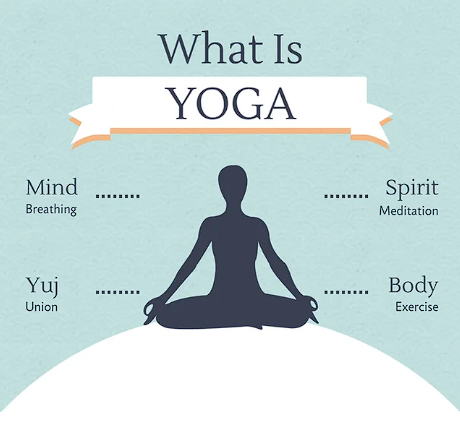Yoga isn’t just exercise—it’s a balanced blend of movement, breath, mindfulness, and community. It’s perfect for anyone seeking greater flexibility, calm, and resilience. Let’s break it down.
1. What Is Yoga?
Originating in ancient India, yoga combines physical postures (asanas), breath work (pranayama), meditation, and spiritual reflection. Today, it’s widely practiced globally for its transformative health benefits .

2. Why Begin Yoga?
Physical Perks:
- Flexibility & Mobility: Gentle stretching helps lengthen muscles and joints
- Strength & Posture: Poses like Plank and Cobra build muscle tone and correct alignment
- Balance & Coordination: Standing on one leg enhances stability—useful in everyday life
Mental & Emotional Gains:
- Stress Relief & Relaxation: Breath-centric moves and restorative poses reduce cortisol and calm the nervous system
- Mood & Sleep Improvement: Practicing even 10–20 minutes improves mood, energy, and sleep quality
- Immune & Cardiovascular Health: Breathing techniques can boost immunity and circulation
Holistic & Social Value:
- Mind–Body Connection: Yoga cultivates internal awareness, helping you honor your body’s cues
- Community & Support: Classes foster social interaction and accountability
Empowerment at Home: Every Woman to Receive Free Tailoring Machine Under ‘Modi Sarkar’ Yojana!
- Adaptable Practice: Gentle, restorative, or dynamic—there’s a yoga style for everyone
3. Simple Beginner Poses
These foundational asanas are easy to start with and highly effective:

| Pose | Benefits |
|---|---|
| Tadasana (Mountain) | Improves posture and grounding |
| Adho Mukha Svanasana (Downward Dog) | Strengthens arms & stretches back |
| Balasana (Child’s Pose) | Relaxes mind, releases back tension |
| Marjaryasana–Bitilasana (Cat–Cow) | Mobilizes spine, relieves stiffness |
| Bhujangasana (Cobra) | Opens the chest, strengthens the spine |
| Setu Bandha Svanasana (Bridge) | Activates core, supports lower back |
| Savasana (Corpse Pose) | Deep relaxation and integration |
4. Essential Breathing & Mindful Practices
- Diaphragmatic Breath: Deep belly breaths for a calmer nervous system
- Alternate Nostril (Nadi Shodhana): Balances energy and mind
- Bee Breath (Bhramari): A calming hum to soothe anxiety
- Mindfulness: Focus on the present moment—be aware of body and breath
5. Getting Started: Tips & Safety
- Begin with short, frequent sessions (10–20 min, 3× per week) and build from there
- Choose your style:
- Restorative/Gentle – for relaxation
- Hatha – classic alignment
- Vinyasa – for a light workout
- Use props (blocks, straps) and ask instructors for modifications
- Respect your body: Avoid pushing into pain; progress gradually
- Post-meal wait: Practice 2–3 hours after eating; hydrate afterwards
- Consult a professional if you have health conditions
6. Integrating Yoga into Daily Life
- Desk-friendly yoga: Simple seated stretches can reduce work-related tension
- Walking yoga: Combine mindful movement with breath for a mobile routine
- Community events: Join local International Yoga Day celebrations—great for motivation and unity

Final Thoughts
Yoga offers more than just flexibility—it brings strength, clarity, inner calm, and a sense of belonging. Just a few minutes a day can kickstart a life-changing journey. So unroll your mat, breathe deeply, and let yoga inspire you—every day.
“Earn ₹500 Cashback Instantly with Gpay – Limited-Time Offer!”








